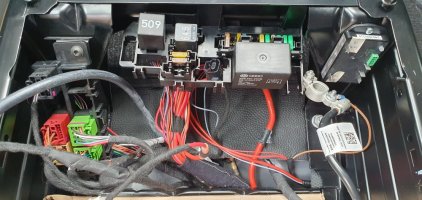RoadRunnerDU
New Member
My T6.1 came with the leisure battery. I want to take it out and replace with my own dual battery setup with DC/DC charger 200ah lithium and so on.
I read multiple discussion here and had a look under my seat and there it LOTS of stuff. I get this is all connected to the brains of the car ECU and has smart alternator and other trickery built in.
Is there a way to remove/bypass most of this ?
Assume the little thing on negative is a BMS. 200/300A fuses seem a bit excessive for those cables. Also never figured out what actually is connected to that battery.
Anyway. What I'm after is just to disconnect most of this and connect a DC/DC charger that I can feed into my own battery. If someone knows a discussion in here and can point me in the right direction that would be great.

I read multiple discussion here and had a look under my seat and there it LOTS of stuff. I get this is all connected to the brains of the car ECU and has smart alternator and other trickery built in.
Is there a way to remove/bypass most of this ?
Assume the little thing on negative is a BMS. 200/300A fuses seem a bit excessive for those cables. Also never figured out what actually is connected to that battery.
Anyway. What I'm after is just to disconnect most of this and connect a DC/DC charger that I can feed into my own battery. If someone knows a discussion in here and can point me in the right direction that would be great.









